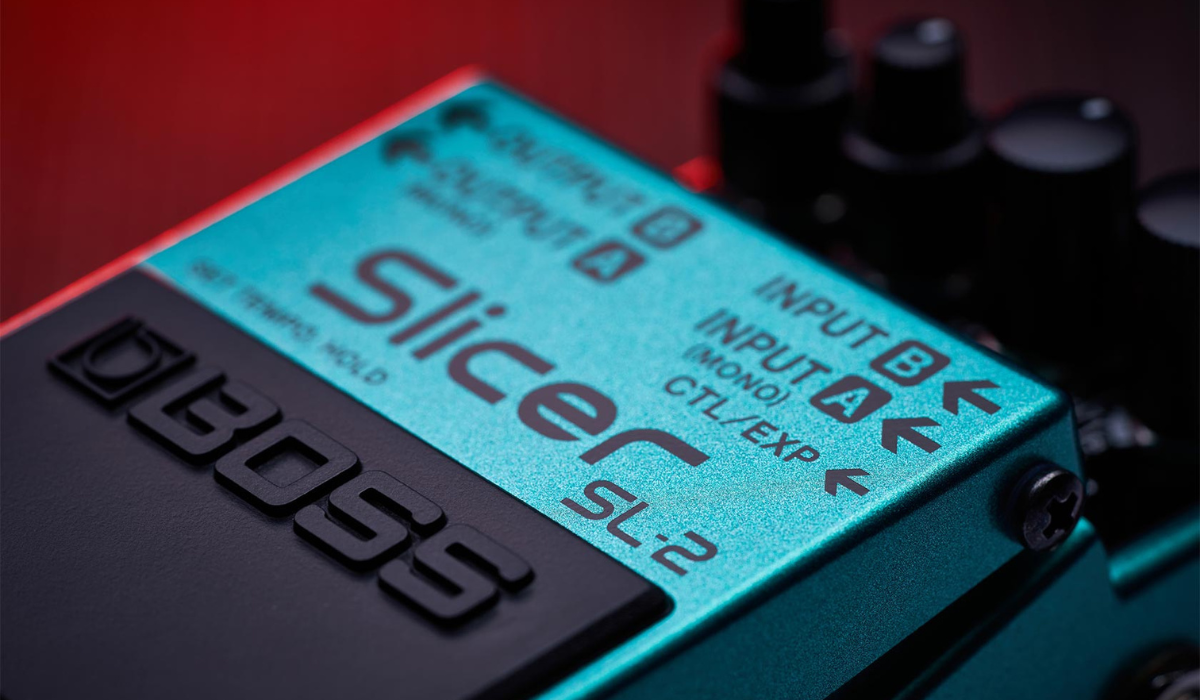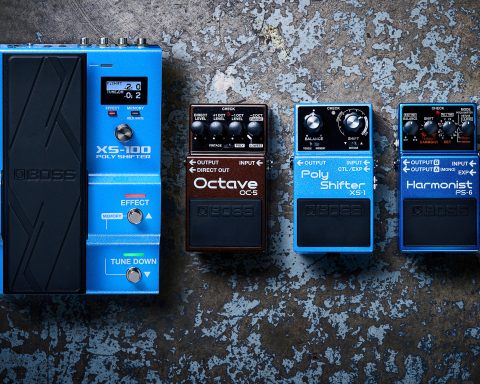The BOSS SL-2 Slicer is a fun, inspiring, and utterly unique stompbox. With its extensive sound-forging capabilities and intuitive controls, this compact pedal can expand any musician’s sonic palette. Though it may seem unusual to the uninitiated, the versatile SL-2 is regarded by many as an indispensable creative tool. This is especially true for forward-thinking guitarists who enjoy modern sounds. Read on to discover five ways the SL-2 Slicer can enhance your music-making.
What is a Slicer?
The SL-2 Slicer is an advanced BOSS compact pedal that ‘slices’ your signal into different rhythmic patterns. Multiple internal effects and output options make creating dynamic, stereo-enhanced grooves a piece of cake.
With virtually limitless possibilities, musicians can personalize sounds in mono or stereo that make performances shine with originality. Take Scott Reynolds from CLT DRP; he leverages a BOSS Slicer in tandem with a looper to lay the foundations of numerous standout tracks. Then there’s Nick Reinhart, who uses one to showcase his own attention-grabbing sounds.
Out of the box, the SL-2 includes 88 memory locations with pre-loaded patterns (eight types with 11 variations for each). Further options can be explored using the dedicated BOSS Tone Studio app. Access BOSS Tone Central to download a choice of expansion packs.
How to Use a Slicer Pedal
The SL-2 sports six knobs split across two concentric pots (Balance/Tempo and Attack/Duty) and two rotary switches (Variation and Type). This layout provides comprehensive control in a pedalboard-friendly form factor.
Balance adjusts the blend between the direct (dry) signal and the Slicer effect sound. Tempo manually sets the BPM (this is overridden when the SL-2 receives a MIDI beat clock signal from an external device). Using these controls, players can dial in anything from a soft, slow throb to an extreme ring mod-like tone.
Attack shapes the waveform, while Duty determines its length. These parameters enable users to experiment with sounds ranging between smooth amp-style tremolo and percussive square-wave cut.
The Variation knob allows one of 11 pattern variations to be selected. Meanwhile, the Type knob switches between eight different slicer types. These include single and dual slicers, tremolo, pitch-shifting, and more.
Five Slicer Pedal Uses
Drum Machine
The SL-2 Slicer can produce head-turning results by embellishing rhythm variations with pitch-shifting effects. It’s even possible to make retro drum machine-style sounds using a basic instrument signal.
This works best when the SL-2 gets fed a sustained guitar note with ample distortion or noise from a synthesizer. Set Balance fully clockwise, Tempo to taste, Attack to 3 o’clock, and Duty to 9 o’clock. Then position Variation at number 6 and Type at number 3. Experiment with different variations to find the most appropriate sound.
By setting Attack and Duty as above, the SL-2 will generate distinctly percussive slices. Coupled with pitch-shifting, this creates simple, lo-fi beats reminiscent of vintage drum machines.
"The SL-2 will generate distinctly percussive slices. Coupled with pitch-shifting, this creates simple, lo-fi beats reminiscent of vintage drum machines."
Synth Tone
The SL-2’s Attack and Duty controls define the fundamental sound of sliced and pitched effects. Used subtly, they can add a gentle, rhythmic overlay that preserves guitar technique. However, when used aggressively, they can transform a guitar into something decidedly more synthesizer-like.
Set Attack almost fully clockwise to elicit a snappy, hard-hitting sound and position Duty around 11 o’clock to eclipse the guitar’s natural dynamics and character. This brings forth a digital synth-like quality when each note is played.
"The SL-2 can transform a guitar into something decidedly more synthesizer-like."
This method works with most of the SL-2’s variation settings but is especially effective using the Single (Type 1 and 2) modes. These options conjure arpeggiator-like tones—perfect for guitarists looking to double on synth duty.

Hard Ring Mod
While the SL-2 excels at complex and expressive rhythmic patterns, it can also produce classic sci-fi ring mod noises. To achieve this, turn the Balance and Tempo knobs fully clockwise, then set Attack to an aggressive wave shape.
As per the previous example, this method obscures playing dynamics and induces a less organic tone. The intensity of the tremolo and the extremely high slicing rate make it difficult for the human ear to differentiate pitch, resulting in a unique kind of bit-crushed ring modulator effect.
"Try holding a single note during the pitch-corrected section of the pattern to create a repetitive bass line."
Harmonizer
Another great function of the SL-2 is that it can act as a harmonizer to create organ-like pitch-shifted guitar tones. To achieve this effect, select the Harmonic mode using the Type knob, then turn Balance and Attack fully clockwise.
When Balance is set to maximum, no direct signal will be heard, meaning only the keyboard-like effect will be audible. Experiment with Harmonic mode to find interesting combinations of pitch-shifted notes.
Looping Bass Lines
The SL-2’s Harmonic mode can be used to form looping bass lines alongside a guitar part. To do this, turn Balance fully clockwise to eliminate the direct signal and set Attack and Duty to 12 o’clock.
Listen to the pitch pattern of the variation when striking a note or chord. Try holding a single note during the pitch-corrected section of the pattern and playing between. This will create a repetitive bass line while allowing you to add variety and melody.

A Creative Tool
The BOSS SL-2 Slicer is a remarkable pedal that produces captivating sounds in myriad ways. Far more than just a guitar effect, it can be a valuable source of inspiration that leads to fertile creative ground. Indeed, many musicians use the SL-2 as a writing tool, enabling them to execute ideas bursting with originality and flair.






